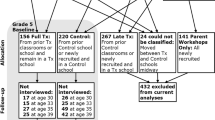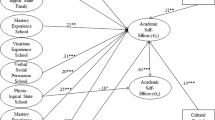Abstract
Self-control (SC) plays a critical role in development across the life course; poor SC is a common antecedent of outcomes with high public health and societal burden including lower educational and occupational attainment, problem substance use, depression, obesity, and antisocial behavior. Further, SC is associated with academic self-efficacy and academic success; therefore, optimizing SC in early childhood could have long-term health and educational implications. However, it remains unknown whether the impact of early childhood prevention programs varies by baseline levels of SC, and whether better SC in early childhood leads to better self-efficacy in adolescence. This study leverages a sample of predominately low-/middle-income Black participants (n = 678) who were part of a randomized universal preventive trial in first grade (1993–1995). Teacher-reported SC was measured at baseline. Utilizing a three-step latent transition analysis, transitions between SC classes and academic self-efficacy trajectories were explored. Intervention status was explored as a predictor of the transition. Results suggest that teacher-rated SC in early childhood predicts academic self-efficacy up to 11 years later. Moderation analyses suggest that there are individual differences in prevention program effectiveness by baseline behavioral regulation skills. Implications for school-based universal prevention programming having an impact on low risk children and methods for exploring moderation within a prevention context are discussed.



Similar content being viewed by others
References
Asparouhov, T., & Muthén, B. (2014). Auxiliary variables in mixture modeling: Three-step approaches using M plus. Structural equation modeling: A multidisciplinary Journal, 21(3), 329–341.
Bandura, A., Barbaranelli, C., Caprara, G. V., & Pastorelli, C. (2001). Self-efficacy beliefs as shapers of children’s aspirations and career trajectories. Child Development, 72, 187–206. https://doi.org/10.1111/1467-8624.00273
Britner, S. L., & Pajares, F. (2006). Sources of science self-efficacy beliefs of middle school students. Journal of Research in Science Teaching, 43, 485–499. https://doi.org/10.1002/tea.20131
Campbell, F. A., Pungello, E. P., & Miller-Johnson, S. (2002). The development of perceived scholastic competence and global self-worth in African American adolescents from low-income families: The roles of family factors, early educational intervention, and academic experience. Journal of Adolescent Research, 17, 277–302. https://doi.org/10.1177/0743558402173004
Capaldi, D. M. (1991). Co-occurrence of conduct problems and depressive symptoms in early adolescent boys: I. Familial factors and general adjustment at Grade 6. Development and Psychopathology, 3(3), 277–300.
Caprara, G. V., Vecchione, M., Alessandri, G., Gerbino, M., & Barbaranelli, C. (2011). The contribution of personality traits and self-efficacy beliefs to academic achievement: A longitudinal study: Personality traits, self-efficacy beliefs and academic achievement. British Journal of Educational Psychology, 81, 78–96. https://doi.org/10.1348/2044-8279.002004
Coll, C. G., Crnic, K., Lamberty, G., Wasik, B. H., Jenkins, R., Garcia, H. V., & McAdoo, H. P. (1996). An Integrative model for the study of developmental competencies in minority children. Child Development, 67, 1891–1914. https://doi.org/10.1111/j.1467-8624.1996.tb01834.x
Datar, A., & Chung, P. J. (2018). Childhood self-control and adolescent obesity: Evidence from longitudinal data on a national cohort. Childhood Obesity, 14, 238–247. https://doi.org/10.1089/chi.2017.0217
de Ritter, D. T. D., Lensvelt-Mulders, G., Finkenauer, C., Stok, F. M., & Baumeister, R. F. (2012). Taking stock of self-control: A meta-analysis of how trait self-control relates to a wide range of behaviors. Personality and Social Psychology Review, 16, 76–99.
Duckworth, A. L., Taxer, J. L., Eskreis-Winkler, L., Galla, B. M., & Gross, J. J. (2019). Self-control and academic achievement. Annual Review of Psychology, 70, 373–399. https://doi.org/10.1146/annurev-psych-010418-103230
Embry, D. D. (2002). The good behavior game: A best practice candidate as a universal behavioral vaccine. Clinical Child and Family Psychology Review, 5, 273–297.
Ensminger, M. E., Forrest, C. B., Riley, A. W., Kang, M., Green, B. F., Starfield, B., & Ryan, S. A. (2000). The validity of measures of socioeconomic status of adolescents. Journal of Adolescent Research, 15, 392–419. https://doi.org/10.1177/0743558400153005
Granic, I., & Patterson, G. R. (2006). Toward a comprehensive model of antisocial development: A dynamic systems approach. Psychological Review, 113, 101–131. https://doi.org/10.1037/0033-295X.113.1.101
Harter, S. (1988). Manual for the self-perception profile for adolescents. University of Denver.
Hoza, B., Gerdes, A. C., Hinshaw, S. P., Arnold, L. E., Pelham, W. E., Molina, B. S. G., Abikoff, H. B., Epstein, J. N., Greenhill, L. L., Hechtman, L., Odbert, C., Swanson, J. M., & Wigal, T. (2004). Self-Perceptions of competence in children with ADHD and comparison children. Journal of Consulting and Clinical Psychology, 72, 382–391. https://doi.org/10.1037/0022-006X.72.3.382
Ialongo, N., Poduska, J., Werthamer, L., & Kellam, S. (2001). The distal impact of two first-grade preventive interventions on conduct problems and disorder in early adolescence. Journal of Emotional and Behavioral Disorders, 9(3), 146–160.
Ialongo, N. S., Werthamer, L., Kellam, S. G., Brown, C. H., Wang, S., & Lin, Y. (1999). Proximal Impact of two first-grade preventive interventions on the early risk behaviors for later substance abuse, depression, and antisocial behavior. American Journal of Community Psychology, 27, 599–641. https://doi.org/10.1023/A:1022137920532
Johnson, S. B., Voegtline, K. M., Ialongo, N. S., Hill, K. G., & Musci, R. J. (in press). Self-control in early childhood predicts success in the transition to adulthood. Development and Psychopathology.
Kim, H. K., Capaldi, D. M., Pears, K. C., Kerr, D. C. R., & Owen, L. D. (2009). Intergenerational transmission of internalising and externalising behaviours across three generations: Gender-specific pathways. Criminal Behaviour and Mental Health, 19, 125–141. https://doi.org/10.1002/cbm.708
McGuire, S., Manke, B., Saudino, K. J., Reiss, D., Hetherington, E. M., & Plomin, R. (1999). Perceived competence and self-worth during adolescence: A longitudinal behavioral genetic study. Child Development, 70, 1283–1296.
McGuire, S., Neiderhiser, J. M., Reiss, D., Hetherington, E. M., & Plomin, R. (1994). Genetic and environmental influences on perceptions of self-worth and competence in adolescence: A study of twins, full siblings, and step-siblings. Child Development, 65, 785–799. https://doi.org/10.1111/j.1467-8624.1994.tb00783.x
Moffitt, T. E., Arseneault, L., Belsky, J., Dickson, N., Hancox, R. J., Harrington, H., Houts, R., Poulton, R., Roberts, B. W., Ross, S., Sears, M. R., Thomson, W. M., & Caspi, A. (2011). A gradient of childhood self-control predicts health, wealth, and public safety. Proceedings of the National Academy of Sciences, 108, 2693–2698. https://doi.org/10.1073/pnas.1010076108
Nylund-Gibson, K., Grimm, R., Quirk, M., & Furlong, M. (2014). A latent transition mixture model using the three-step specification. Structural Equation Modeling: A Multidisciplinary Journal, 21, 439–454. https://doi.org/10.1080/10705511.2014.915375
Petras, H., Masyn, K., & Ialongo, N. (2011). The developmental impact of two first grade preventive interventions on aggressive/disruptive behavior in childhood and adolescence: An application of latent transition growth mixture modeling. Prevention Science, 12, 300–313. https://doi.org/10.1007/s11121-011-0216-7
Robbins, S. B., Lauver, K., Le, H., Davis, D., Langley, R., & Carlstrom, A. (2004). Do psychosocial and study skill factors predict college outcomes? A Meta-Analysis. Psychological Bulletin, 130, 261–288.
Schafer, J. L., & Graham, J. W. (2002). Missing data: Our view of the state of the art. Psychological Methods, 7, 147–177. https://doi.org/10.1037/1082-989X.7.2.147
Stapleton, L. M., McNeish, D. M., & Yang, J. S. (2016). Multilevel and single-level models for measured and latent variables when data are clustered. Educational Psychologist, 51, 317–330. https://doi.org/10.1080/00461520.2016.1207178
Webster-Stratton, C. (1984). Randomized trial of two parent-training programs for families with conduct-disordered children. Journal of Consulting and Clinical Psychology, 52, 666–678.
Werthamer-Larsson, L., Kellam, S., & Wheeler, L. (1991). Effect of first-grade classroom environment on shy behavior, aggressive behavior, and concentration problems. American Journal of Community Psychology, 19, 585–602. https://doi.org/10.1007/BF00937993
Zajacova, A., Lynch, S. M., & Espenshade, T. J. (2005). Self-efficacy, stress, and academic success in college. Research in Higher Education, 46, 677–706. https://doi.org/10.1007/s11162-004-4139-z
Funding
This study was supported by NIH HD093643 to SBJ and RJM and NIH MH57005 and DA11796 to NSI.
Author information
Authors and Affiliations
Corresponding author
Ethics declarations
Ethics Approval
All procedures performed in the current study were in accordance with the ethical standards of the institutional and/or national research committee and with the 1964 Helsinki declaration and its later amendments or comparable ethical standards.
Informed Consent
Informed consent was obtained from all individual. participants included in the study. The study was approved by the Johns Hopkins Bloomberg School of Public Health IRB.
Conflict of Interest
The authors declare that they have no conflict of interest.
Additional information
Publisher's Note
Springer Nature remains neutral with regard to jurisdictional claims in published maps and institutional affiliations.
Rights and permissions
About this article
Cite this article
Musci, R.J., Voegtline, K., Raghunathan, R. et al. Differential Impact of a Universal Prevention Program on Academic Self-Efficacy: the Moderating Role of Baseline Self-Control. Prev Sci 23, 513–522 (2022). https://doi.org/10.1007/s11121-021-01315-7
Accepted:
Published:
Issue Date:
DOI: https://doi.org/10.1007/s11121-021-01315-7




